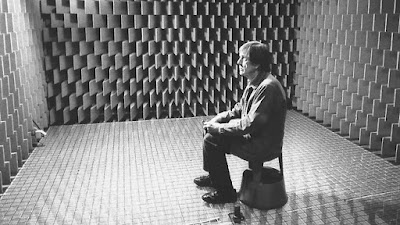In some newspaper I recently read that due to constant warming, noise pollution from air conditioners and fans is also increasing - it hums, buzzes, clanks and blows everywhere. According to the article, people would be subjected to additional stress from this noise pollution and would want nothing more than silence.
The problem: silence is a purely theoretical concept; it doesn't happen in real life. This can be seen in so-called "anechoic" chambers (more correctly, "anechoic rooms"), as exist at the University of Vienna and many other universities.
Such a room at Harvard University was visited by the famous composer John Cage in 1951. What he heard in this probably most silent room in the world, he had explained to him afterwards: on the one hand the murmur of his own blood and on the other hand the high-pitched buzzing of his nervous system. ¹ So even in an anechoic room one cannot speak of absolute silence.
This experience not only shaped his musical philosophy (and ultimately led to the legendary composition 4'33) - until the last years of his life, it made Cage not only stoically endure the street noise below his New York apartment, but become a constant source of inspiration: "Wherever we are, what we hear is mostly noise. When we ignore it, it disturbs us. When we listen to it, we find it fascinating". ²
4'33 shows the way quite exemplarily. As is well known, this work by Cage, which is still very controversially received today, consists of a concert pianist lifting the piano lid during the performance, starting a stopwatch, and then doing NOTHING for exactly four minutes and 33 seconds.
What Cage meant by this is that if we are forced to listen to our surrounding sounds within a certain period of time, we can compose our own "music" with this material - which in the case of the concert situation at hand consists of the whispering, rustling, murmuring, and chair-backing of a highly irritated audience.
4'33 shows the way quite exemplarily. As is well known, this work by Cage, which is still very controversially received today, consists of a concert pianist lifting the piano lid during the performance, starting a stopwatch, and then doing NOTHING for exactly four minutes and 33 seconds.
What Cage meant by this is that if we are forced to listen to our surrounding sounds within a certain period of time, we can compose our own "music" with this material - which in the case of the concert situation at hand consists of the whispering, rustling, murmuring, and chair-backing of a highly irritated audience.
By the way, this is also a wonderful exercise recommended in some introductions to "composition": Take a certain situation during the day (for example, during a walk, on the way to work) and listen carefully to the surrounding sounds during this period of time - given a bit of imagination, these sounds can be put together in your head to form a real symphony.
***
The reason for this lies in the so-called Clustering Illusion, which, according to its definition, "describes the human property of attributing meaning to random patterns that inevitably occur in sufficiently large amounts of data." ³ A variant of this is so-called Pareidolia - the dubious ability of our hyperactive brains to immediately recognize some kind of meaning in what we consider disordered environments like this.
Hasn't everyone seen a face in the irregularities of a wall? Recognizing faces in random structures is a perfect example of pareidolia and, as in the case of the "Martian face," can even go around the world as a headline. Pareidolia can also be used as an explanation for just about all "ghost photos" that circulate on the Internet and are not deliberately faked anyway.
Of course, the whole thing works also on the level of hearing: Here, too, our brain tries to filter out something familiar to us from the disordered patterns of a sound - this then ranges from the slight audio hallucinations described earlier to the "heavenly music" received from supernatural forces to the "dead" speaking to us from the beyond via radio or to the so-called "reversals" said to have been discovered when playing popular songs backwards.
By the way, the meanings of these phenomena ascribed by esotericists and conspiracy theorists can be demystified quite easily: Unless you are told beforehand what you are going to hear (a mandatory practice in such circles) and your brain then dutifully confirms this interpretation, you will hear only what these alleged phenomena really are - a purely random arrangement of weird sounds.
Incidentally, in the case of the described Pareidolia, there is also a close relationship to the so-called Apophenia - a symptom of schizophrenia in which perceptions in random patterns begin to take on a personal level of meaning. If that is the case, it is very urgent to do something about your own mental health. We all know one or the other tragic case of "personal messages" being transmitted to a mentally ill person via the radio, TV or other media; in almost all cases, this is a relatively sure sign of psychosis.
However, this should not stop us from listening to nice music from fans. At least the stress level regarding ambient noise can be wonderfully reduced or decreased. In fact, there is already a real industry that has assimilated the phenomena of ASMR and White Noise - but that is the subject of the next part, which you can read here soon.



